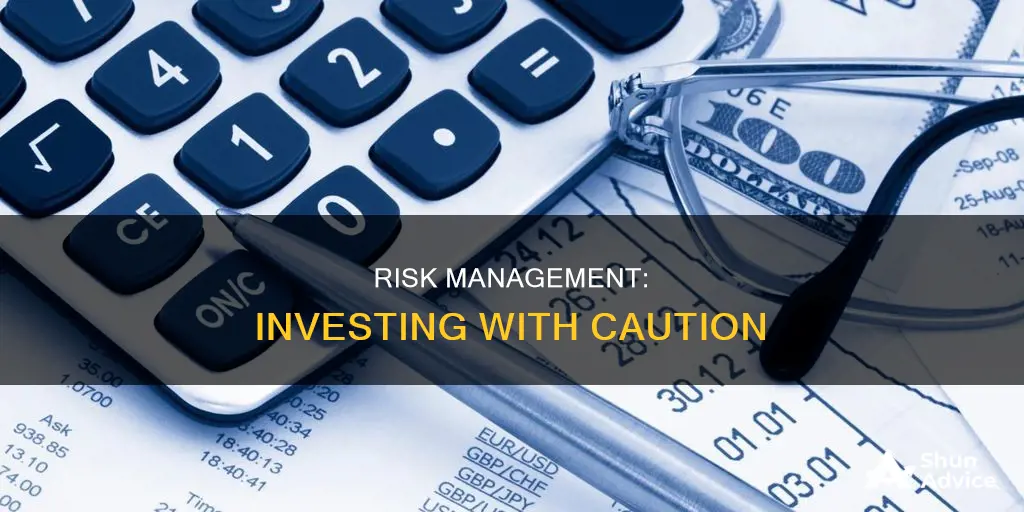
Risk is an important consideration when investing because it can impact every investment decision you make. All investments carry some degree of risk, whether you are purchasing shares, buying cryptocurrency, or investing in property. Risk is the uncertainty and potential for financial loss when you invest in an asset. It is the chance that an investment's actual gains will differ from the expected outcome or return. Understanding your risk tolerance level, which is the amount of investment risk you are willing and able to accept, can help you make the right investment decisions.
| Characteristics | Values |
|---|---|
| Definition | The chance that an outcome or investment's actual gains will differ from an expected outcome or return |
| Possibility | Losing some or all of an original investment |
| Quantification | Assessing historical behaviours and outcomes |
| Risk Management Strategies | Diversification, hedging, standard deviation, beta, Value at Risk (VaR), Capital Asset Pricing Model (CAPM) |
| Risk Factors | Investor's personality, lifestyle, age, time horizon, liquidity, inflation, interest rate fluctuations, market volatility, business solvency, location, demand, supply, illiquidity, regulatory or legislative environments, economic downturns |
| Risk vs Return | Higher risk = higher potential returns |
| Risk Tolerance | An investor's ability and willingness to lose some or all of an investment in exchange for greater potential returns |

Risk and reward
The relationship between risk and reward is fundamental in finance. The greater the amount of risk an investor is willing to take, the greater the potential return they seek. This is because investors who take on higher risks demand greater returns to compensate for the potential losses they may incur. As such, investments with higher risks may have the potential for greater returns, but they may not align with an investor's risk tolerance or appetite.
An investor's risk tolerance refers to their ability and willingness to lose some or all of an investment in exchange for greater potential returns. It is influenced by factors such as their comfort level with risk, liquidity needs, time horizon, and the importance of the financial goal. For example, an investor with a long-term financial goal may be willing to take on more risk by investing in stocks or bonds, while an investor with a short-term goal may prefer the lower risk of cash investments.
It is important to note that higher risk does not always equate to higher returns, and there are no guarantees. Additionally, while diversification and asset allocation are effective strategies for managing risk, they do not guarantee against losses. However, by understanding the nature of risk and implementing risk management strategies, investors can make more informed decisions that align with their financial goals and risk tolerance.
In summary, when considering investments, it is crucial to carefully weigh the risks against the potential rewards. By evaluating their risk tolerance and understanding the different types of risks involved, investors can make more informed decisions and strive to achieve their financial objectives.
Revenue, Investments, and Owner's Equity: Understanding the Interplay
You may want to see also

Risk tolerance
An investor's risk tolerance is determined by their investment goals, time horizon, liquidity needs, and the importance of the investment goal to their financial well-being. For example, an investor saving for retirement may have a higher risk tolerance, as they have a longer time horizon and can afford to take on more risk in pursuit of higher returns. On the other hand, an investor saving for a down payment on a house may have a shorter time horizon and a lower risk tolerance, as they cannot afford to lose their investment due to market volatility.
It's important to note that risk tolerance is not static and can change over time as an investor's goals, financial circumstances, and time horizons shift. Therefore, investors should regularly review their risk tolerance and adjust their investment strategies accordingly.
Understanding one's risk tolerance is essential for making informed investment decisions. It helps investors plan their portfolio allocation, ensuring that their investments align with their financial goals, risk appetite, and ability to take on risk.
Equity Securities: Understanding Your Investment Options
You may want to see also

Risk management
Understanding Risk
Risk in investing refers to the degree of uncertainty and potential financial loss associated with an investment decision. It encompasses the possibility of losing some or all of the original investment. Risk can manifest in various forms, including market risk, business risk, liquidity risk, concentration risk, inflation risk, and more. It's important to recognize that risk is multifaceted and can be influenced by internal and external factors within a company, as well as broader market conditions.
Assessing Risk Tolerance
An investor's risk tolerance refers to their ability and willingness to incur losses in pursuit of greater potential returns. It's essential to consider both aspects of risk tolerance—willingness and ability. While willingness tends to remain relatively constant, an individual's financial ability to take risks may fluctuate over time. Factors such as liquidity needs, time horizon, and the importance of the financial goal play a significant role in determining one's financial capacity to assume risk.
Implementing Risk Mitigation Strategies
While it is impossible to eliminate investment risk entirely, there are strategies to manage and mitigate it. Two fundamental approaches are asset allocation and diversification. Asset allocation involves distributing investments across different asset classes, such as stocks, bonds, and cash, to balance risk and return. Diversification, on the other hand, entails spreading investments within an asset class across various industries, sectors, or regions to reduce the impact of specific risks. Additionally, risk can be mitigated through hedging and insurance products, although these options often come with higher costs.
Weighing Risk and Return
The relationship between risk and return is a fundamental concept in finance. Generally, higher-risk investments are associated with the potential for greater returns. Investors demand higher returns to compensate for taking on additional risk. When evaluating investment opportunities, it's crucial to carefully consider the potential rewards against the level of risk involved.
Monitoring and Adjusting
In conclusion, risk management is a critical aspect of investing that requires a comprehensive understanding of risk, a realistic assessment of risk tolerance, and the implementation of strategies to manage and mitigate potential losses. By effectively managing risk, investors can make more informed decisions and work towards achieving their financial objectives.
Options Trading in India: A Beginner's Guide to Investing
You may want to see also

Types of risk
Risk is an important consideration when investing as it can impact every investment decision you make. All investments carry risk, and prudent investors carefully weigh risk against potential rewards.
There are several types of risk, and they can be broadly categorized as systematic and unsystematic. Systematic risk, also known as market risk, affects an entire economic market or a large percentage of the total market. This type of risk is challenging to mitigate through portfolio diversification. Examples of systematic risk include:
- Interest rate risk: This is the risk of losing money due to changes in interest rates. It applies to debt investments such as bonds, and changes in interest rates can also affect the value of real estate.
- Inflation risk: Inflation erodes the purchasing power of money over time, and this type of risk is particularly relevant for cash or debt investments like bonds.
- Currency risk: This type of risk applies when investing in foreign markets, as changes in exchange rates can impact the value of an investment.
- Liquidity risk: This is the risk of being unable to sell an investment or withdraw money when needed.
- Country risk: This is the risk that a country will not be able to honour its financial commitments, which can affect the performance of financial instruments in that country and others it has relations with.
Unsystematic risk, on the other hand, affects only a specific industry or company. This type of risk can often be managed through diversification. Examples of unsystematic risk include:
- Business risk: This is the risk associated with a company's ability to operate profitably and covers factors such as management, products, marketing strength, and financial strength.
- Operational risk: This is the risk of losses due to day-to-day operations, including system failures, human errors, fraud, or other internal issues.
- Credit or default risk: This is the risk that a borrower will be unable to meet their contractual obligations, and it is particularly relevant for investors holding bonds.
- Reinvestment risk: This is the risk that an investor will not be able to reinvest cash flows from an investment at the same rate of return as the original investment.
- Political risk: This is the risk that an investment's returns will suffer due to political instability or changes in a country.
Equity Investments: What Are They and How Do They Work?
You may want to see also

Risk and time
The relationship between risk and time is an important consideration when investing. Risk is the chance that an investment's actual gains will differ from the expected outcome or return. It includes the possibility of losing some or all of an original investment. Time horizon, on the other hand, refers to the length of time an investor plans to hold an investment before selling it.
In general, the longer an investor's time horizon, the more risk they can afford to take on. This is because a longer time horizon provides a greater opportunity to recover from any losses incurred if an investment does not perform as expected. For example, an investor who is saving for retirement over several decades may be able to accept more risk in their investment portfolio, as they have a longer time horizon and can ride out any market volatility.
Conversely, if an investor has a short time horizon and needs access to their funds in the near future, a less risky investment strategy is generally recommended. This is because there is a reduced opportunity to recover from losses, and more stable investments are needed to ensure funds are available when required.
It is worth noting that while time horizon is a key factor in determining the appropriate level of risk for an investment, it is not the only consideration. Other factors such as an investor's risk tolerance, investment goals, and human capital (ability to generate income from work) also play a significant role in the decision-making process.
Additionally, it is important to understand the different types of risks involved in investing. Systematic risk, also known as market risk, affects the entire economic market or a large percentage of it. This type of risk is challenging to mitigate through portfolio diversification. Unsystematic risk, on the other hand, affects only a specific industry or company and can be managed through diversification.
Understanding the relationship between risk and time horizon, as well as the different types of risks involved, can help investors make more informed decisions about their investment strategies and better manage their portfolios.
How Initial Investment Impacts Owner's Equity
You may want to see also
Frequently asked questions
Risk is the uncertainty and potential for financial loss when investing in an asset. It is the chance that an investment's actual gains will differ from the expected outcome or return.
All investments carry some degree of risk. Risk can impact every investment decision an individual makes. Understanding the basics of risk and how it is measured can help investors avoid unnecessary and costly losses.
Risk-averse investors may avoid volatile stocks and opt for low-risk bonds and cash. However, these investments may not provide sufficient returns to meet long-term financial goals, especially when factoring in inflation. On the other hand, investors with a higher risk appetite may allocate a significant portion of their portfolio to stocks and riskier fixed-income investments, such as high-yield bonds, to pursue higher returns.
Investors can manage risk by understanding their risk tolerance, diversifying their investments, and considering asset allocation strategies. Additionally, individuals can assess their financial ability to take risks by considering factors such as liquidity needs, time horizon, and the importance of the financial goal.







